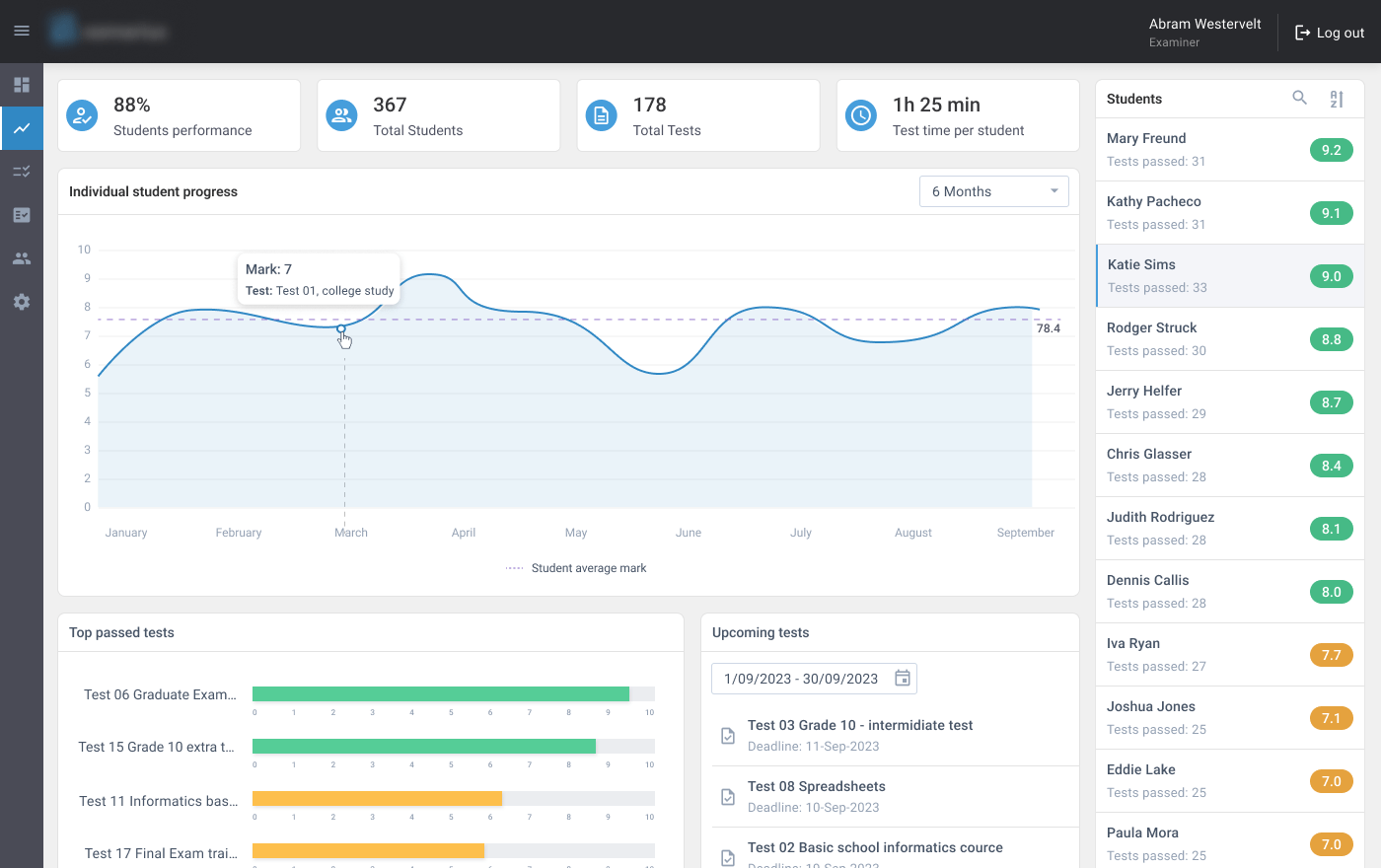Summary
In today’s fast changing education scenario, software solutions have become a must-have to enrich learning and to improve administration efficiency. Schools, colleges and other educational institutions are more and more confronted with the dilemma of whether to go for a SaaS (Software as a Service) solution or an on-premise software system.
As educational organizations navigate this decision, they must weigh various factors to determine the best fit for their technological infrastructure. There are unique features as well as benefits and challenges of both the SaaS and on-premise software, so let’s go deeper in details to discover the better choice.
The Current State of Education Software
The pandemic significantly accelerated the adoption of educational software, as many schools implemented remote learning policies and embraced online solutions to ensure continuity in education. Also, public schools still remain the largest market for educational software, benefiting from government budgets that support the acquisition of software and computers for students and teachers.
The current state of education software solutions is marked by significant growth and widespread adoption, driven by the increasing need for digital tools in educational settings. According to a report by Statista, the global education software market is predicted to reach approximately $11.61 billion in revenue by 2025, reflecting a year-on-year growth of nearly $200 million. This growth is largely attributed to the rising demand for e-learning platforms, Learning Management Systems (LMS), and other educational technologies that facilitate remote and hybrid learning environments.

Globally, the use of technology in education is also highlighted in the UNESCO Global Education Monitoring Report, which emphasizes the importance of using technology in improving the quality of education and reaching disadvantaged learners. The report underscores the need for education systems to prioritize learners’ interests and ensure that digital technologies support, rather than replace, human interaction in education.
As a result, the integration of technology in education has led to the development of a wide range of software applications designed to support various aspects of teaching and learning. From LMS that facilitate online courses and track student progress to administrative software that streamlines operations, such as enrollment, scheduling, and communication, the role of education software is more critical than ever.
As educational organizations strive to meet the demands of modern learners and educators, they are increasingly turning to advanced software solutions to provide flexible, scalable, and secure environments that support both in-person and remote learning. This shift has brought about a crucial decision-making process for schools, colleges, and universities: choosing between Software as a Service (SaaS) and on-premise software systems. Each option offers distinct advantages and challenges, making it essential for institutions to carefully evaluate their specific needs and goals. That is why it is important to understand what you are going to choose from.
Read Also The Test of Time: How Online Platforms Reshape Traditional Educational Assessments
Understanding Specifics of SaaS and On-premise Education Software Solutions
When it comes to choosing between SaaS and on-premise education software solutions, it’s essential to understand the unique characteristics and benefits of each option.
Thus, SaaS solutions are cloud-based services that are hosted and maintained by a third-party provider. SaaS systems are accessed via the internet, allowing users to log in from any location with an internet connection. This accessibility makes SaaS particularly appealing for institutions that support remote or hybrid learning environments. Additionally, SaaS providers typically handle all updates, maintenance, and security measures, reducing the IT burden on educational organizations if they don’t have relevant tech-savvy specialists.
This model has gained popularity due to its flexibility and ease of use. However, there are challenges that educational establishments can face:
- Data Security. Potential risks associated with storing sensitive data on external servers.
- Internet Dependency. Requires a stable internet connection for optimal performance.
- Limited Customization. Often less customizable compared to on-premise solutions.
On the other hand, on-premise software solutions are installed and run on the institution’s own servers and infrastructure. This setup offers greater control over the software environment, including data security and vast customization options, allowing you to create and deploy new features. Organizations with specific regulatory requirements or unique operational needs may prefer on-premise solutions for their ability to tailor the software to their exact specifications. However, this control comes with the responsibility of managing and maintaining the system, which can require significant IT resources and expertise.
This model offers greater control and customization but requires more significant investment and maintenance. However, this option also has the challenges an institution may run into:
- Higher Initial Costs. Requires investment in hardware, software, and IT personnel.
- Maintenance. Ongoing maintenance and updates are the responsibility of the organization.
- Scalability. As the number of users increases, scaling up the system can become more complex and costly.
So, who should choose on-premise software and who should go for a SaaS solution? Of course, it all depends on the needs of your particular organization. For example, schools or universities that need highly customized solutions and have specific security or compliance requirements might prefer on-premise software. Those schools that want to provide access to educational resources from anywhere, facilitating remote learning, will likely choose SaaS.
Ultimately, the decision of choosing between SaaS and on-premise education software development services depends on the specific needs, goals, and resources of each educational institution. By carefully evaluating factors such as cost, flexibility, security, and long-term sustainability, schools and colleges can make informed choices that best support their educational objectives.
Read Also Open-Source Software vs. Proprietary Software: Being in Two Minds While Weighing All Pros and Cons
How Examarius Easily Deals with the Dilemma
In case you are lost, Examarius offers a versatile solution that addresses the dilemma of choosing between SaaS and on-premise education software. Designed to streamline exam management and assessment processes, it provides the flexibility catering to the diverse needs of educational organizations.
For institutions leaning towards SaaS because of the possibility to use the system online, Examarius offers the convenience of online access, allowing educators and students to interact with the system from anywhere with an internet connection. Our system also shares the support for scalability with the SaaS model, making it easy to adjust the system based on the number of users or the volume of exams being administered.
On the other hand, for organizations that prefer on-premise solutions, Examarius can be installed and run on the company’s own servers. This option provides complete control over data security and customization, allowing you to tailor the system to the specific requirements. By hosting the software on-premise, schools and colleges can ensure compliance with regulatory standards and maintain full ownership of their data.
Here’s, for example, you can check how we helped one of our clients to create a customized version of the product to fit the requirements of their institution:

Source: Online Exam System
Besides that, Examarius excels in offering a user-friendly interface and robust features that enhance the exam creation, administration, and grading processes. Its customizable platform supports a wide range of exam types and formats, making it suitable for various educational contexts. Additionally, Examarius includes technologies that protect the integrity of the exam process and prevent cheating. For example, each student will have a randomized order of questions and answers during the exam.
| SaaS Education Software | On-Premise Education Software | Examarius | |
| Accessibility |
Anywhere with internet |
Limited to local network |
Anywhere with internet |
| Cost |
Subscription-based, lower initial cost |
Higher initial investment |
Low investment |
| Customization |
Limited |
Extensive |
Unlimited |
| Maintenance |
Handled by provider |
Handled by institution |
Handled by institution or XB Software (at additional cost) |
| Data Security |
Dependent on provider |
Controlled by institution |
Controlled by institution |
| Scalability |
Easily scalable |
More complex |
Easily scalable |
Covering both SaaS and on-premise deployment advantages, Examarius empowers educational organizations to choose the solution that best aligns with their operational needs and strategic goals. Whether prioritizing ease of use and scalability or control and customization, Examarius offers a reliable and efficient online test platform to support the evolving demands of modern education. Besides that, it offers unparalleled benefits over on-premise alternatives:
- Enhanced Data Security. With Examarius, your institution retains full control over sensitive data, ensuring it is protected by your own security protocols.
- Customization. Examarius can be tailored to meet the unique needs of your institution, providing a bespoke solution that SaaS platforms often cannot match.
- Reliability. Examarius can operate independently of internet connectivity, ensuring uninterrupted access to critical educational tools and resources.
- Integration. The system can be seamlessly integrated with your existing systems, providing a cohesive and efficient operational environment.
- Long-Term Cost Efficiency. While our product requires initial investment, the long-term costs are lower as there are no recurring subscription fees.
Conclusions
Often, the choice between SaaS and on-premise software solutions is a critical decision for schools, colleges, and other educational organizations. Each option offers distinct advantages and challenges, from the scalability and convenience of SaaS to the control and customization of on-premise systems. By carefully evaluating factors such as cost, flexibility, security, and long-term sustainability, you can make informed decisions that align with your unique needs and goals.
So, if you need help from a custom software development company in building a suitable education software solution or want to know more about Examarius, please contact us, and we will offer you the best option.